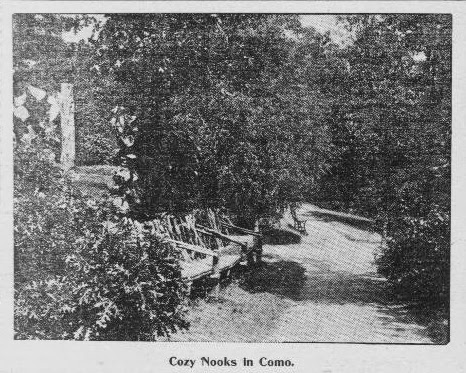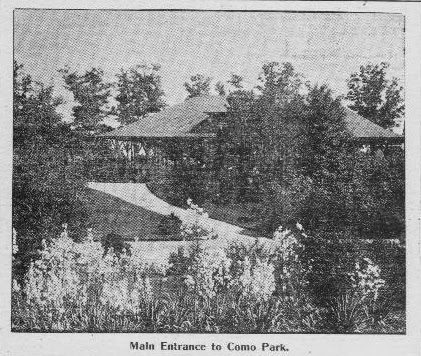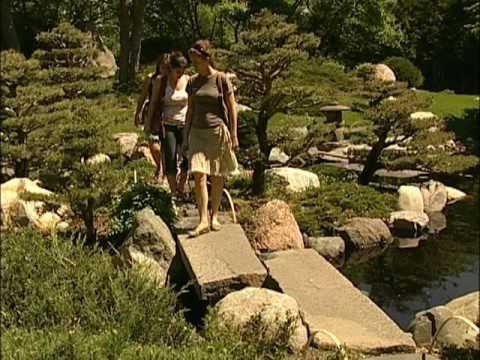The first known person of Euro-American descent to settle in the Como area was Charles Perry. In 1848 he took possession of a 160-acre claim that would later become part of Como Park. In his short time there he farmed the land, grew potatoes, and raised cattle. Due to an increased population around him, Perry soon left the land, moving north and settling near (present-day) Lake Johanna.
In 1851 East Coast developer Henry McKenty came to Minnesota and purchased Perry’s claim. He dreamed of turning his holdings at Como into a resort area. He needed a link to St. Paul and spent $6000 to construct a road leading from downtown to the lake. His “Como Road” roughly followed the path of today’s Como Avenue.
Unfortunately for McKenty, his dream for Como Park wouldn’t come to be. The Financial Panic of 1857 bankrupted him. On August 10, 1869, after many years of fighting to try and regain his earnings, the man once considered one of the wealthiest in St. Paul took his own life. His “Como Road” leading to the resort of his dreams soon fell into disrepair and became known as the “swamp route.”

In the 1870s famous landscape architect Horace W.S. Cleveland urged growing cities throughout the country to set aside land for public parks before it became scarce and prices skyrocketed. To Cleveland, parks were an important refuge from the hustle and bustle of urban life — they offered visitors a chance to see nature without leaving the limits of the city. Cleveland recognized many natural features in St. Paul that were worthy of preserving.
City leaders listened. In 1872, in the midst of an economic boom due to the rapid industrial development that took place after the Civil War, St. Paul decided that it needed an urban park system. This departure from the previous system of simple open spaces would offer a system of parkways and boulevards to allow easy travel to visit and interact with city parks.
A Legislative act on February 29, 1872, called for the appointment of five commissioners to purchase land within a convenient distance of St. Paul for a park. A bond of $100,000 was provided by the city. Nearly 260 acres were purchased on the north and west of Lake Como in 1873 (the Lake was included) to eventually become the home of Como Park.
The boom that preceded the purchase of parkland was soon after followed by a bust. An economic recession in 1873 had residents of the city questioning a purchase that many were initially behind. They didn’t understand how the city could use the money to buy parkland when there were so many more important needs to be met. The economic downturn meant another fourteen years before anything would be done with the land.

During that time officials began to consider other options for the Como land. In 1875 a Legislative enactment passed calling for the purchased land to be broken up into 5-acre lots and given away as bonuses to “industrial enterprises” in an effort to help stimulate the economy. In 1882 the City Council allocated 40-acres for a workhouse on parkland. It was built to house prisoners from St. Paul and the Ramsey County area. The building opened in February of 1883.
In 1887 funds became available and a Legislative enactment created a City Park Board. $225,000 was allocated for the improvement of the city’s park system; $25,000 of that money was to be used for Como Park. Horace W.S. Cleveland was hired to design the Park as well as the parkways that ran through it. Como Park soon began to take shape.
In 1891 Frederick Nussbaumer was named the Superintendent of Parks. He believed in Cleveland’s naturalistic philosophy, but also had a vision of a beautiful park with many recreational opportunities for visitors. Nussbaumer felt that every inch of the park should be enjoyed.
Como Park blossomed under Nussbaumer. By 1893, electric rail cars reached the area, making Como Park accessible to all of St. Paul. The first Shelter Pavilion, greenhouse, and boathouse and docks were also added. By 1896 the “Gates Ajar” and “Schiffman Fountain” had been installed. Como Zoo began in 1897 with the donation of three deer. Soon a large free-range pen housed animals native to the region like elk, deer, and bison. In 1897 an interurban route came through the park with passengers from both Minneapolis and St. Paul.
At the beginning of the 20th Century, Como Park was considered by many to be one of the finest parks in the United States. It was a local marvel. Many felt that you had not truly seen St. Paul until you had visited Como.
Japanese Garden at Saint Paul’s Como Park(Note: There is some debate as to how the Lake Como (formerly Sandy Lake) got its name. Many believe that Perry, born in the Swiss-Italian Alps named it after Lake Como in Italy. Many others feel that McKenty named it Como because it sounded more exotic than Lake Sandy – and therefore easier to sell.)
Works Cited:
Bergerson, Roger “First Como Settler Didn’t Stay Long.” Park Bugle. May 20, 2013. http://www.parkbugle.org/first-como-settler-didnt-stay-long/.
Castle, Henry A. History of St. Paul and Vicinity: A Chronicle of Progress and a Narrative Account of the Industries, Institutions, and People of the City and Its Tributary Territory. Volume II. Chicago: Lewis Pub., 1912.
“Como Park,” St. Paul Globe, July 3, 1904,
http://chroniclingamerica.loc.gov/lccn/sn90059523/1904-07-03/ed-1/seq-58/.
Kunz, Virginia B. “A Day in the Life of Henry McKenty.” Minnesota History 56, no. 4 (Winter 1998-99): 235-37. http://collections.mnhs.org/MNHistoryMagazine/articles/56/v56i04p235-237.pdf.
McGuire, Colleen “Best of Home Guide to Como Park: The Central Park of St. Paul.” CBS Minnesota. June 11, 2011.
http://minnesota.cbslocal.com/2011/06/11/guide-to-como-park-the-central-park-of-saint-paul/.
Ramsey County Historical Society. “Como Neighborhood.” http://www.rchs.com/neighborhoods/como_neighborhood.htm.
Schmidt, Andrew J. “Pleasure and Recreation for the People: Planning St. Paul’s Como Park.” Minnesota History 58, no. 1 (Spring 2002): 40-58. http://collections.mnhs.org/MNHistoryMagazine/articles/58/v58i01p040-058.pdf.
Shinomiya, Sharon. “Como Park: A Brief Historical Tour of One of Saint Paul’s “beauty Spots”.” Como Park: District 10 Como Community Council. http://www.district10comopark.org/uploads/Como+Site+History_2_2.pdf.
Shinomiya, Sharon. “Como Park History Tour: Part I.” Como Park: District 10 Como Community Council. May 4, 2009. http://www.district10comopark.org/uploads/Como+Park+History+Tour+Short+Version+for+D10_2.pdf.
“St. Paul’s Beautiful Parks Are Made Ready for Summer Visitors,” St. Paul Globe, April 10, 1904, http://chroniclingamerica.loc.gov/lccn/sn90059523/1904-04-10/ed-1/seq-24/.
Warner, George E. History of Ramsey County and the City of St. Paul,including The. S.l.: British Library, Historic, 2011.
